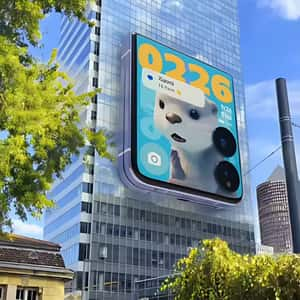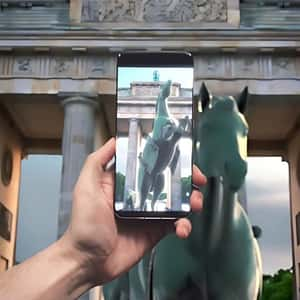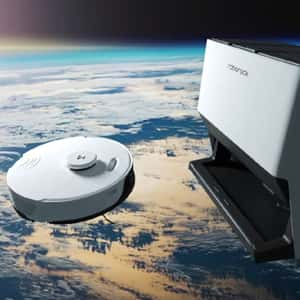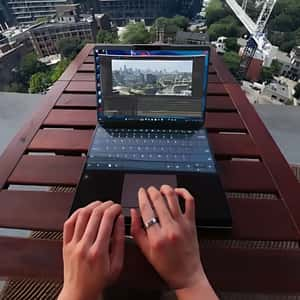The Tools Behind FOOH Part III: Shooting and Capturing Footage
Discover the technical aspects of capturing footage for fake out-of-home advertising.

In the previous part of our tech blog series, we dove into the planning stage of Fake Out Of Home productions. Our advert has been carefully planned, taking into account all the foreseeable production issues and preparing for unforeseen problems.
Now it’s time to move from planning to execution. This chapter explains how to get high-quality footage for Fake Out-Of-Home productions. It covers important aspects like great tracking, seamless compositing, and believable integration.
All these elements start here.
Want a refresher? Check out The Tools Behind FOOH Part II: Pre-Production Planning to revisit the key steps before execution.
Camera Equipment for FOOH Production
There are many ways to capture high-quality footage, and each option has its own perks. Choosing the right tools, like camera types, lenses, or mobile phones, can greatly affect the final result. This approach allows you to customize depending on different production needs.
Mobile Phones vs. Cameras
Many mid-range and high-end mobile phones feature compact, quality lenses. They also include advanced software for image correction. These features enable mobile phones to capture high-quality videos.
FOOH productions are usually fast-paced. They often need the camera operator to work alone, recording with autofocus lenses. Such a streamlined production can take advantage of a mobile phone. Its portability, ease of use, and fast access to editing tools are major benefits.
Mirrorless or DSLR cameras, along with professional cinema cameras with interchangeable lenses, offer excellent video quality for top-tier Fake Out Of Home ads. Cinema cameras also provide better handling options through a large number of accessories.
DSLR, mirrorless, and cinema cameras have a key advantage over mobile phones: larger photo sensors that capture a higher dynamic range. This helps in post-production, offering more flexibility in adjusting footage.
Camera Lenses
In FOOH production, wide-angle lenses ranging from 12mm to 35mm are typically used. As the goal is to replicate the wide field of view that is common in phone cameras.
Some DOPs prefer prime lenses, while others prefer the flexibility of zoom lenses. Consider the lens’s sharpness, its distortion correction, and how easy it is to handle.
Gimbals
A gimbal is highly beneficial for producing smooth, stable handheld shots by compensating for unwanted camera shakes and vibrations. It ensures high-quality footage. This lets you move smoothly and dynamically, no bulky tripod or steadicam needed.
On-Set Best Practices for FOOH
During the storyboarding phase in pre-production, shot framing typically follows the established direction. It is important that the captured footage remains clear and easy to read when displayed on the smaller screens of mobile phones.
For an FOOH ad to be effective, the video should look as if it were captured by an average mobile user encountering something surprising.
If actors or objects are part of the scene, their movements and actions need to sync with the CGI elements. For example, actors might need to react to or interact with digital objects that aren’t visible. This requires them to have precise timing, direction, and placement.
Storyboards or previsualization made ahead of time can help everyone work better together. In addition, physical markers or objects can guide the actors and the camera.
This process starts way back in the ideation phase—explained in The Tools Behind FOOH Part I
It’s always helpful to capture a few shots without actors or focus objects. These can be useful in post-production when clean plates are needed to remove unwanted or distracting elements.
Tip: Certain mobile apps can leverage spatial capture technologies to simplify the process of digitally reconstructing scenes. This makes the integration of visual effects and distortion correction more seamless.
Resolution and Camera Settings
Using high-resolution cameras and the appropriate camera settings (e.g., frame rate, sensitivity, video recording settings) is critical to ensuring that the footage retains its clarity and quality, making it easier to integrate high-quality CGI elements without losing detail.
Ensuring the best image quality settings are used for the recorded footage is essential. Shooting in 4K (Ultra HD) is key for quality tracking and visual effects. It also lets you crop within the shot frame.
Video Recording Formats
For Fake Out Of Home productions that require more control over the final output, RAW video formats and Log video formats capture a broader range of values, helping to preserve highlights and shadows more effectively. This provides greater flexibility in post-production compared to standard compressed video formats.
In contrast, SDR videos are designed for direct display on typical monitors. They offer a “what you see is what you get” experience without the need for extensive post-production adjustments.
RAW files, in particular, store unprocessed sensor data and allow for non-destructive editing. This means adjustments can be made without losing the original data. And this is especially helpful if changes need to be reverted or refined during the editing and integration process.
Mobile phones have increasingly advanced in their video recording capabilities, with many high-end smartphones now offering Log and RAW video formats, which are typically seen in professional-grade cameras.
Frame Rates
Most common mobile phones have displays with refresh rates of 60 Hz, 90 Hz, or 120 Hz. The footage should use either 30 frames per second or a multiple of 30 to ensure that motion in the resulting video appears natural on the screen.
Fractional frame rates, like 24, 25, or 48 fps, can lead to motion jitter. This happens when frames are dropped during playback to maintain the video’s original speed on the display.
Camera Angles and Movement
Camera angles and movements should be planned carefully to match the size and dynamics of the CGI elements. This includes tracking shots, the camera’s placement related to the planned virtual elements, and the camera’s interaction with the scene to ensure continuity with digital elements.
Focusing on the Action
While cinematographers on FOOH productions typically use wide-angle lenses with smaller apertures (which significantly reduce the issue of out-of-focus blurring), it’s still important to give careful thought to the position of the focal point to ensure that the space of the action - live, virtual or both - remains in focus for optimal sharpness. This consideration is unavoidable when telephoto lenses are used.
Environment & Real-World Elements
The production team should leverage their creativity to effectively integrate visual effects added later, while avoiding unnecessary visual clutter, ensuring that the final advertisement is both impactful and believable.
The real-world environment must be considered in its interaction with CGI elements. This includes reflections, shadows, and how the digital elements will interact with real-world lighting and surfaces.
On set, visual clutter should be avoided, particularly in the center of the FOOH action, to make the ad easily digestible.
Recording the environment
Dealing with unwanted reflections and shadows can be tough in post-production. You also have to recreate lifelike object surfaces that blend well with the footage. Plus, handling elements like foliage in front of computer-generated objects adds to the challenge.
Therefore, it is essential to capture as many reference images as possible. Both from the camera’s position and from other angles, as these help streamline work-intensive tasks in post-production. Keep the weather conditions consistent in both the footage and reference images.
Lighting
Good lighting is key to showing off the product well. It helps make the final result look great. In FOOH productions, lighting depends on what’s available. This can be natural or artificial.
For outdoor shots, scout during pre-production. Check how lighting changes at different times of the day. Virtual scouting is possible with apps like Sunseeker and Shadowmap.
Need inspiration? Our FOOH Library features standout ads from brands across major cities.
High Dynamic Range Images
To quickly reproduce the lighting and reflections as they were on location, HDRI spheres can be used. High dynamic range images come from taking several standard dynamic range photos in quick succession. You capture these either from a tripod or another stable spot. Then, you blend them based on their exposure values.
By using automatic panoramic stitching combined with an HDR blending solution, it’s possible to create spherical panoramas that replicate the lighting of a real-world environment. Compact 360 cameras like the Insta360, Ricoh Theta, and mobile apps like HDReye can help streamline the process of capturing such HDR spherical panoramas for FOOH productions.
Weather
Weather conditions can greatly influence video quality in fast-paced FOOH shoots outside. Changes in light, like cloud cover, direct sunlight, or weather shifts, can create uneven exposure and color balance. This can make it hard to keep a consistent look in different shots.
High humidity or smog, for example, can reduce visibility and impact the clarity of distant shots. These factors create a hazy effect that may affect the overall aesthetic.
Additionally, elements like rain, wind, or humidity can affect camera equipment, lenses, and even the stability of shots. This can potentially introduce unwanted motion blur or lens fog.
Producers often have to quickly adapt by adjusting settings or repositioning to mitigate these weather-related challenges and maintain high-quality footage under changing conditions.
Keep the action in the frame
Capturing high-quality footage for FOOH productions requires a blend of technical expertise, creativity, and an understanding of technical requirements for the integration of visual effects. By ensuring the footage follows the creative vision, carries enough detail, and has adequate lighting on location, filmmakers can ensure that their content not only meets but exceeds the standards for a seamless FOOH ad.
In the rapidly evolving world of digital advertising, staying ahead of trends and continuously refining techniques is essential for creating impactful and visually stunning experiences that resonate with audiences.



